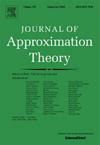由3 × 3周期加权的六边形平铺引起的矩阵值正交多项式
IF 0.6
3区 数学
Q2 MATHEMATICS
引用次数: 0
摘要
矩阵值正交多项式(MVOP)出现在双周期平铺模型的研究中。特别令人感兴趣的是当阶趋于无穷大时它们的极限行为。近年来,对阿兹特克钻石双周期多米诺骨牌铺层的MVOP进行了成功的分析。六边形双周期菱形平铺的MVOP更为复杂。本文研究了具有3 × 3周期性的六边形平铺的一个特殊子类。这个特殊的子类导致了一个具有额外对称性的谱曲线,使我们能够明确地在一个外场中找到一个平衡测度。平衡测度给出了MVOP的行列式零点的渐近分布。相关的g函数出现在MVOP的强渐近公式中,该公式是我们从MVOP的Riemann-Hilbert问题的最陡下降分析中得到的。本文章由计算机程序翻译,如有差异,请以英文原文为准。
Matrix valued orthogonal polynomials arising from hexagon tilings with 3 × 3-periodic weightings
Matrix valued orthogonal polynomials (MVOP) appear in the study of doubly periodic tiling models. Of particular interest is their limiting behavior as the degree tends to infinity. In recent years, MVOP associated with doubly periodic domino tilings of the Aztec diamond have been successfully analyzed. The MVOP related to doubly periodic lozenge tilings of a hexagon are more complicated. In this paper we focus on a special subclass of hexagon tilings with 3 × 3 periodicity. The special subclass leads to a genus one spectral curve with additional symmetries that allow us to find an equilibrium measure in an external field explicitly. The equilibrium measure gives the asymptotic distribution for the zeros of the determinant of the MVOP. The associated -functions appear in the strong asymptotic formula for the MVOP that we obtain from a steepest descent analysis of the Riemann–Hilbert problem for MVOP.
求助全文
通过发布文献求助,成功后即可免费获取论文全文。
去求助
来源期刊
CiteScore
1.90
自引率
11.10%
发文量
55
审稿时长
6-12 weeks
期刊介绍:
The Journal of Approximation Theory is devoted to advances in pure and applied approximation theory and related areas. These areas include, among others:
• Classical approximation
• Abstract approximation
• Constructive approximation
• Degree of approximation
• Fourier expansions
• Interpolation of operators
• General orthogonal systems
• Interpolation and quadratures
• Multivariate approximation
• Orthogonal polynomials
• Padé approximation
• Rational approximation
• Spline functions of one and several variables
• Approximation by radial basis functions in Euclidean spaces, on spheres, and on more general manifolds
• Special functions with strong connections to classical harmonic analysis, orthogonal polynomial, and approximation theory (as opposed to combinatorics, number theory, representation theory, generating functions, formal theory, and so forth)
• Approximation theoretic aspects of real or complex function theory, function theory, difference or differential equations, function spaces, or harmonic analysis
• Wavelet Theory and its applications in signal and image processing, and in differential equations with special emphasis on connections between wavelet theory and elements of approximation theory (such as approximation orders, Besov and Sobolev spaces, and so forth)
• Gabor (Weyl-Heisenberg) expansions and sampling theory.

 求助内容:
求助内容: 应助结果提醒方式:
应助结果提醒方式:


